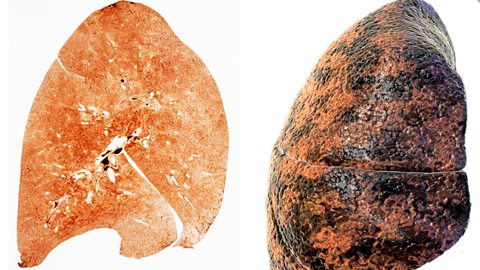Smoking and cardiovascular disease
Smoking increases the risk of cardiovascular diseaseDisease relating to the heart and the blood vessels. in several ways:
- Smoking damages the lining of the arteriesBlood vessels that carry blood away from the heart., including the coronary arteryOne of the arteries that supplies the heart muscle with oxygen and glucose so that it can continually respire and therefore contract.. The damage encourages the build-up of fatty material in the arteries. This can lead to a heart attackWhen the supply of blood to the heart is suddenly blocked. or a strokeDamage to the brain caused by bleeding or blood clots in the brain's blood vessels..
- Inhalation of carbon monoxidePoisonous gas produced during incomplete combustion. in cigarette smoke reduces the amount of oxygenGaseous element making up about 20% of the air, which is needed by living organisms for respiration. that can be carried by the blood.
- The nicotineThe addictive substance found in tobacco and tobacco smoke. in cigarette smoke increases the heart rate, putting strain on the heart.
- Chemicals in cigarette smoke increase the likelihood of the clotA clump of platelets and blood cells that forms when a blood vessel is damaged., resulting in a heart attack or stroke.
Lung disease
Smoking may result in lung diseases.

A person may develop COPDCOPD or chronic obstructive pulmonary disease is the name to several lung diseases that restrict air flow in the lungs and cause breathing difficulties for a patient. – chronic obstructive pulmonary disease. This condition includes the diseases bronchitisInflammation of the bronchi and bronchioles. and emphysema Disease in which the walls of the alveoli break down, reducing the surface area for gas exchange in the lungs..
In COPD:
- smoking damages the bronchiolesThe many small, branching tubules into which the bronchi subdivide. and can eventually destroy many of the alveoliTiny air sacs in the lungs, where gas is exchanged during breathing. in the lungs
- the airways become inflamed and mucusSlimy white protein, which lines the respiratory tract and alimentary canal., which normally traps particles in the lungs, builds up
- the patient becomes breathless, and finds it more and more difficult to obtain the oxygen required for respirationThe chemical change that takes place inside living cells, which uses glucose and oxygen to release the energy that organisms need to live. Carbon dioxide is a by-product of respiration.
The damage caused by COPD is permanent. The disease cannot be cured, and can result in death. It is essential that the person seeks medical help to try to prevent progression of the disease.
Lung cancer
The carcinogenA chemical or other agent that causes cancer. in cigarette smoke also cause lung cancer. Almost all cases of lung cancer are caused by smoking – smaller numbers of cases are linked with air pollution and ionising radiationRadiation that is able to remove electrons from atoms or molecules to produce positively charged particles called ions. from radon gas, a radioactiveWhen unstable atoms give off particles that can be harmful to humans.elementA substance made of one type of atom only. found in the environment in some parts of the country.
The vast majority of cases of lung cancer lead to death.
Note that the trend in the rate of developing lung cancer for women has been increasing, while in men is decreasing. The main reason is because numbers of female smokers - unlike men - continued to increase in the 1950s and 1960s before starting to fall. Cancer may take some years to develop, so a fall in female rates of lung cancer is likely to occur later. Evidence also suggests that women are more susceptible to developing the condition.
Effects of smoking on babies
For mothers who smoke during pregnancy:
- smoking increases the risk of miscarriageThe spontaneous or unplanned expulsion of a fetus from the womb before it is able to survive independently.
- the babies and children are more likely to suffer from respiratory infections and an increased risk of asthmaA disease that affects the respiratory system.
- the long-term physical growth and intellectual development of the baby/child is affected
- there is an increased risk of birth defects
- the birthweight of the baby is reduced
Question
The bar chart shows that when mothers smoke more than ten cigarettes a day, the birthweight of their babies is reduced.
Suggest two pieces of additional information that would need to be collected before drawing firm conclusions about the effect of mothers smoking on the birthweight of babies.
- Carry out a similar study of mothers of different age groups to see if similar results could be obtained.
- Check to ensure that other factors - for instance, related to lifestyle factors of the experimental group - could not have affected birthweight.
When parents smoke, there is a greater risk of cot death – sudden infant death syndrome.
Learn more about risk factors for non communicable diseases with Dr Alex Lathbridge.
Listen to the full series on BBC Sounds.
In this podcast, learn the key facts about risk factors for non communicable diseases. Listen to the full series on BBC Sounds.